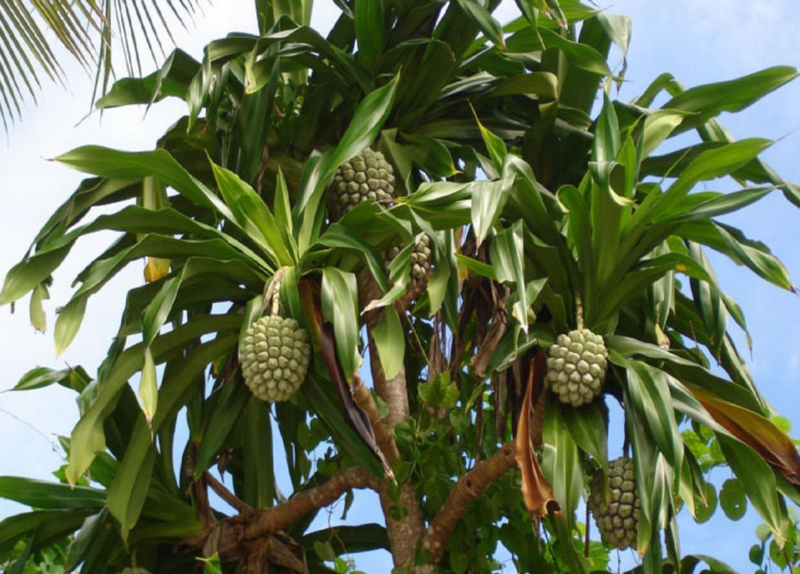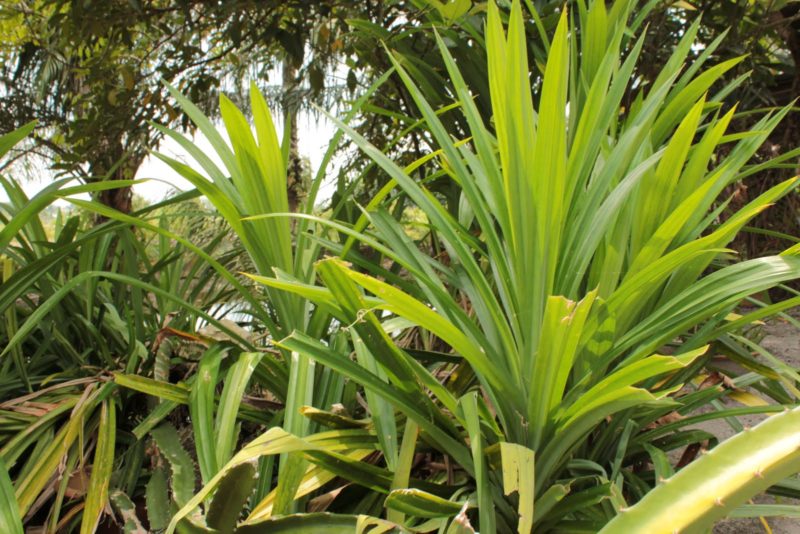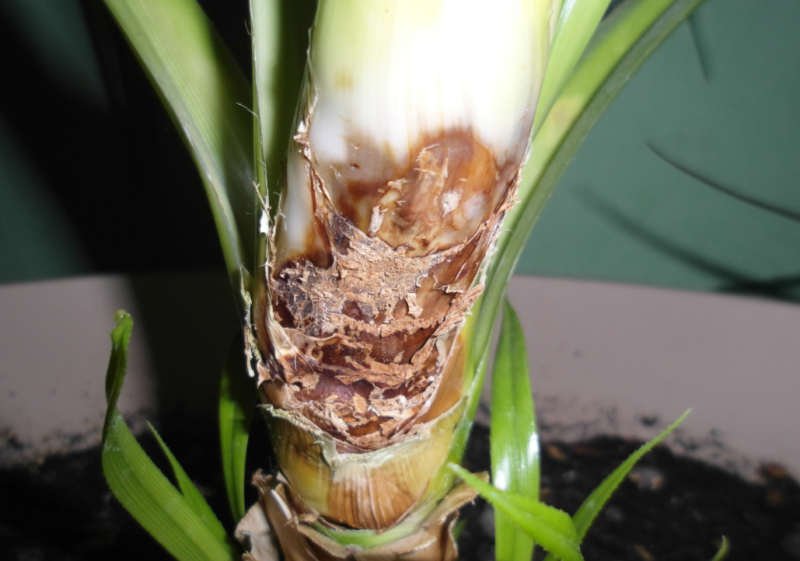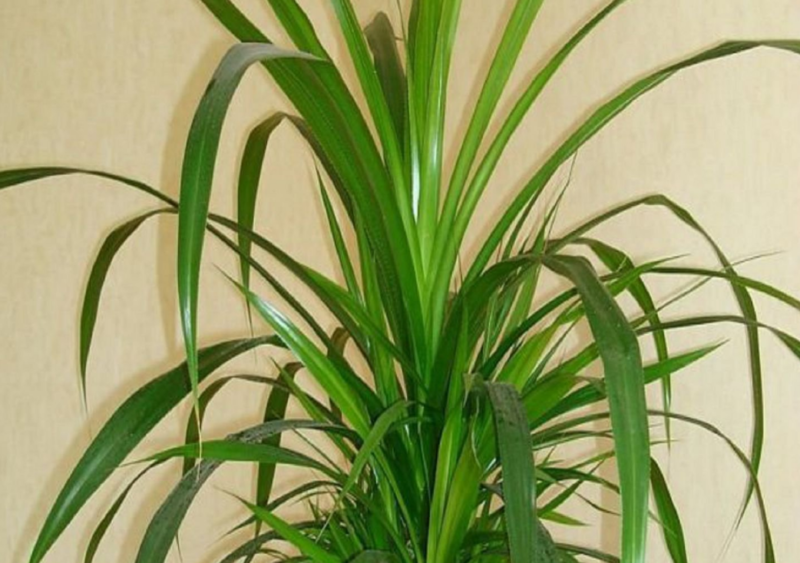The height and diameter of an unusual indoor flower at the age of 5 is up to 1.5 m. Indoor pandanus patiently tolerates dry air and lack of care. The convoluted trunk is supported by strong, stilted roots, the thickness of a pencil;
Material Content:
Types and varieties of helical palm trees
Indoor flower Pandanus (Pandanus) - evergreen shrub or tree. Natural species are most numerous in the tropics of Southeast Asia, Africa and on the island of Madagascar, in Polynesia. These are unpretentious plants with narrow leaves and subordinate roots.
It is interesting! With age, the stalk twists spirally in places of scars left from old leaf blades.
Many gardeners like the household name of pandanus - a helical "palm", which was given to the plant for the unusual structure of the stem and long curved leaves at the top. However, pandanus has nothing to do with palm trees, except for cohabitation in the tropics. The genus Pandanus is part of the Pandanus family. Interesting in form forms and subspecies are grown in residential premises and offices.
Veitch pandanus or hiding — a large “palm” with shiny, serrated along the edge and pointed at the top leaves 6–9 cm wide and 0.8–1.2 m long. The upper leaf blades are almost straight, xiphoid, assembled into a socket. Medium - longer, curved in a semicircle. The spikes on the edge of the leaf blade are short, barely noticeable.
The lower leaves depart from the trunk almost horizontally, move to the side or deviate downward by growing aerial roots. They are gray-brown in color with a dark tip, located at different heights at different angles. There is a variegated subspecies of P. Veich with dark green leathery leaves, light stripes along the central vein. The compacta houseplant is relatively small in size.
Panadanus Sandera is characterized by slow growth, white-yellow stripes on the leaves. These two species more often than other representatives of the genus are grown indoors. Variegated forms are especially popular.
Useful Panadanus is a tree whose height under natural conditions reaches 15–20 m, indoors - no more than 3 m. Long narrow leaves are spirally located on the trunk. They are stiff, straight, dark green with reddish spikes on the edges and on the keel.
"Palms" pandanuses regularly bloom and bear fruit in nature, indoors - very rarely. Plants are monoecious; male and female flowers are formed on the same plant. Pollination occurs with the help of wind, insects and birds. The fruits of some species are eaten.
The nuances of growing in an apartment
Veich's young indoor pandanus looks like a dracaena. There are external similarities, but there are significant differences that must be taken into account. One or more pandanus stems are not as neat as dracaena. With age, the trunk of the earth becomes thinner or rots. The crown is supported by aerial roots of various thicknesses and lengths. It is not necessary to cut off these “sticks” sticking out in different directions.
The lowest subordinate roots deepen into the soil and support a powerful plant.
The adult pandanus has long, hard, spiky leaves that require a lot of space for free growth. The plant is more suitable for a bright hall, a glazed loggia, a winter garden. An adult pandanus looks much more spectacular than a young one. Solid leaves in good light, uniformly bright green, shiny. Variegated pandanuses without light lose their leaf pattern.
Care Features
Pandanus comes from the hot and humid tropics. Need such care at home, which maximally reproduces the conditions of the plant’s native places.
Suitable temperature and lighting
The period of active growth of pandanus is from April to September. At this time, the room temperature should be above 20 ° C. Winter holidays last from October to March. The optimal values for the plant at this time are not lower than 14 ° C. In winter, water less, do not fertilize the soil. A spiral tree can do without a rest period. A tree or bush winter without problems next to a central heating battery or in a bright living room.
The young spiral palm for the first 2-3 years grows well on the windowsills of the southern, eastern or western windows. Then the pandanus needs to choose a bright place near the window or with a source of artificial lighting.
A plant placed on an open balcony, loggia or terrace can stand in the sun before and after dinner. Adult pandanus with props will not be affected by moderate wind, summer rain, and a drop in temperature to 14-15 ° С.
Watering and humidity
Pandanus in nature grows near the water. However, a houseplant does not need abundant watering. From this, a disease can develop in the form of rotting of the lower part of the stem and root system. Using its subordinate roots, the “stilt” pandanus in natural conditions absorbs as much water as it needs. Moderately water the substrate from above or below (into the pan). You can not irrigate the plant, since water enters the axils of the leaves and contributes to decay.
Leaves are dusted with a damp sponge. In hot, dry weather, using a spray gun increases the humidity in the room. Rarely watered in winter, but do not allow the soil in the pot to dry completely. Use soft settled water.
Pandanus is fed only during the growing season - from April to August.Add a fertilizer solution for decorative and deciduous houseplants to water for irrigation or pour into a tray. They feed 1 time in 4 weeks.
Plant transplant
Pandanus grows rapidly at a young age, it needs a more spacious pot. The plant is transplanted every 2 years. The substrate must be nutritious, well permeable. Expanded clay or gravel is poured at the bottom of the tank, compost, peat or its substitute, a little loam are added to the substrate during planting and transplanting. The optimal pH for pandanus is from 5.5 to 6.5 (slightly acidic environment).
It is recommended to work in clothes with long sleeves and gloves so as not to suffer from sharp spikes on the leaves.
An attentive florist will surely notice that the pandanus is annually “pushed” out of the pot every year. This aerial roots lift the plant. It is necessary to transplant the exot or transship once every 2-3 years into a higher pot, add nutritious soil on top. Culture looks better in a tall pot. So that the air roots can penetrate into the substrate, a sufficiently spacious container is selected. There must be a distance of at least 15 cm between the stem and the walls of the dishes.
Pandanus breeding
Many side shoots appear on the stems of the plant. Children 10-15 cm long are torn off, sprinkled with crushed activated carbon, and allowed to dry for several hours. Green cuttings are rooted in a pot with a substrate of equal parts of peat and sand under a plastic glass or in a jar of water.
After the appearance of new leaves, a young pandanus is planted in a pot with soil. Also, for the first time, cover the plant with a transparent glass or a cut plastic bottle. Propagation by shoots does not cause difficulties, allows you to get a large number of plants of your favorite variety.
Pest and Disease Control
Pandanus is very resistant to phytopathogens. The spiral palm is almost not damaged by plant pests. If all indoor flowers are infected with a fungal infection or are infected by insects, then the pandanus remains untouched.
A spider mite, a mealybug, which are very suitable for conditions in the axils of the leaves, can damage the spiral palm. Wipe the infected areas with a cotton pad moistened with a soap-alcohol solution. For moderate lesions, they are sprayed with an insecticide solution. You can use Fitoverm or Aktaru.
Not very prickly pandanus like to gnaw cats living in the house. Four-legged children and the delicate thin tips of young leaves are especially liked. As a result, the plant loses its decorative appearance. The ends of the leaves dry out, covered with yellow-brown strokes and dots.
A typical problem when growing pandanus is a nursing illness. The tips of the leaves dry out, brown spots appear on the green plates with a lack of moisture, dry air. Installing a humidifier in a room or bowl filled with pebbles and water helps. With excess moisture and low air temperature, root decay begins. It is necessary to reduce watering, transplant the plant and transfer it to a warmer room.
Home Care Tips
A large plant in the room needs a large pot, a stable flowerpot. It may be necessary to install supports so that the stem does not deviate to the side and does not fall. If you pick up two pegs of the same color as the trunk, then behind the accessory roots and densely growing children they will be invisible. Strong support is especially necessary for pandanuses, which are carried out to fresh air in the summer.
Too tall a plant can be shortened. With a sharp secateurs or knife, carefully cut off the top of the pandanus. Leaves that begin to turn yellow or interfere are cut off with scissors 1 cm from the trunk. Do not cut off aerial roots. Side shoots of children can be removed or left on the mother plant.
Pandanus is a relatively fast-growing, decorative and deciduous plant, undemanding to care. This is ideal for green decoration of a bright hall, living room.Indoor “palm tree” prefers well-lit places, temperature not lower than 14 ° С, loose soil with low clay content. In summer, pandanus is watered more abundantly, in winter less water is required.





















